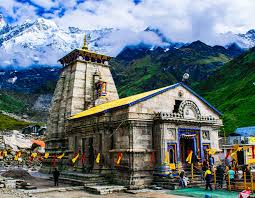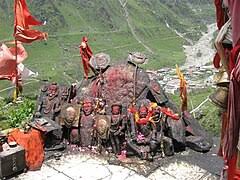Table of Contents
ToggleKedarnath

Kedarnath
Kedarnath is one of the most famous and sacred pilgrimage sites in India, dedicated to Lord Shiva. Located in the Indian state of Uttarakhand, Kedarnath is part of the Char Dham Yatra, which also includes Yamunotri, Gangotri, and Badrinath. It is a prominent temple in the Himalayas, attracting thousands of pilgrims every year. Here’s a detailed look at all the information related to Kedarnath:
1. Location:
- Kedarnath is situated at an altitude of around 3,583 meters (11,755 feet) above sea level, in the Garhwal Himalayas, near the Mandakini River in Uttarakhand, India.
- The temple is nestled among towering snow-covered peaks, offering breathtaking views of the surrounding mountains.
- The town of Kedarnath is located about 220 km from Rishikesh and 42 km from the nearest town of Gaurikund, which is the starting point for the trek to the Kedarnath Temple.
2. The Significance of Kedarnath:
- Kedarnath is one of the 12 Jyotirlingas of Lord Shiva, making it one of the holiest and most revered shrines for Hindus.
- The temple is considered a Swayambhu (self-manifested) form of Shiva, meaning the idol is not crafted by humans but is believed to have appeared naturally.
- Kedarnath holds immense importance in Hindu mythology, with devotees believing that a pilgrimage to Kedarnath helps in attaining moksha (liberation from the cycle of life and death).
- It is part of the Char Dham Yatra, which is considered one of the most important Hindu pilgrimages.
3. History and Mythology:
- Kedarnath Temple is steeped in legend and mythology. According to the Mahabharata, the Pandavas, after the great battle of Kurukshetra, sought Lord Shiva’s blessings to atone for the sins of killing their kin in the war. Lord Shiva, however, was unwilling to meet them and decided to hide in the Kedarnath hills in the form of a bull (Nandi).
- After much effort, the Pandavas found Shiva, but in the form of a bull, which submerged into the ground. The hump of the bull is said to be the manifestation of the Kedarnath Linga.
- It is also believed that the temple was originally built by the Pandavas and later reconstructed by Adi Shankaracharya in the 8th century CE, who established the Jyotirlinga at this site.
- The temple is associated with the legend of Ganga. It is said that Lord Shiva gave his consent to Ganga to descend to Earth, but he asked her to control her flow when she reached the Himalayas to prevent destruction. Ganga, in her river form, is believed to flow through Kedarnath’s waters.
4. Kedarnath Temple Architecture:
- The Kedarnath Temple is built in traditional North Indian (Himalayan) architectural style using large, heavy stones.
- The temple is constructed on a platform made of large, thick stones, which has withstood numerous natural calamities over the years, including earthquakes and floods.
- The temple is dedicated to Lord Shiva and is home to a rectangular-shaped Shiva Linga. The inner sanctum (garbhagriha) contains the idol of Shiva, while the outer walls of the temple are adorned with beautiful carvings of gods, goddesses, and other spiritual motifs.
- A small structure inside the temple houses the idol of Maha Mrityunjaya, another form of Lord Shiva.
- The temple complex includes other shrines dedicated to various deities, such as Lord Ganesha, Lord Parvati, and Lord Krishna.
5. Accessibility:
- Kedarnath is not directly accessible by road. The nearest town is Gaurikund, located about 42 km away, which serves as the base for the trek to Kedarnath.
- Trekking to Kedarnath: Pilgrims typically trek a distance of 16-20 km (depending on the route taken) from Gaurikund to Kedarnath. The trek is steep but scenic, taking about 6 to 8 hours to complete, depending on one’s fitness level.
- There is an option for pony rides or palanquin services for those who cannot undertake the trek.
- For the physically impaired, the helicopter service from Phata or Sersi to Kedarnath is available, though it is subject to weather conditions.
- Best Time to Visit: Kedarnath is only accessible during the summer months due to heavy snowfall in the winter. The temple is open from late April to early November, and the best time to visit is typically between May and June or September to October. Mahashivaratri and Kedarnath’s opening and closing days attract the most pilgrims.
6. Kedarnath’s Natural Environment:
- The temple is located amidst breathtaking scenery, surrounded by majestic snow-capped peaks such as Kedarnath Peak, Mandani Peak, and Kanti Stambh.
- The Mandakini River flows through the valley below, adding to the picturesque beauty of the area.
- The entire region is part of the Kedarnath Wildlife Sanctuary, which is home to a wide variety of flora and fauna, including species like the Himalayan Monal, Bharal (blue sheep), and Musk deer.
7. Important Festivals:
- Maha Shivaratri: This is the biggest festival celebrated in Kedarnath. Devotees gather to worship Lord Shiva, and the temple is decorated with lights and flowers.
- Kedarnath Opening and Closing Dates: The temple remains closed during the winter months, from November to April, due to heavy snow and freezing conditions. The temple is opened on Akshaya Tritiya (usually in April or May) and is closed after Kartik Purnima (usually in November). During the opening and closing ceremonies, special rituals are held.
- Baisakhi: The festival marks the onset of spring and the opening of the temple for the new pilgrimage season.
- Summer Festival: This is held during the months when the temple remains open to pilgrims.
8. Kedarnath’s Historical Relevance:
- Kedarnath, being one of the Char Dham sites, has a profound significance in Hinduism, especially for devotees of Lord Shiva.
- It is one of the most visited pilgrimage sites in India, drawing millions of pilgrims each year from across the country and abroad.
- In 2013, Kedarnath faced devastating floods and landslides that resulted in significant destruction. The temple, however, remained intact. The incident highlighted the challenges of preserving religious structures in such extreme natural conditions, and subsequent rebuilding efforts have helped restore accessibility and safety.
9. How to Reach Kedarnath:
- By Road: Kedarnath is connected to Rishikesh and Haridwar via road. From Rishikesh, you need to drive to Gaurikund, the starting point of the trek to the temple.
- By Train: The nearest railway stations are Rishikesh and Haridwar, both of which are well-connected to major cities like Delhi, Lucknow, and Varanasi.
- By Air: The nearest airport is Jolly Grant Airport in Dehradun, approximately 235 km from Kedarnath. From there, one can travel by road to Gaurikund and then trek to the temple.
- Helicopter Service: Helicopter services to Kedarnath are available from Phata and Sersi, though they are subject to weather conditions.
Conclusion:
Kedarnath is not just a religious site but a symbol of divine presence, natural beauty, and unwavering devotion. The Kedarnath Temple, surrounded by magnificent mountains and the serene Mandakini River, offers a spiritual experience that is unmatched. A pilgrimage to Kedarnath is considered a journey of inner transformation and spiritual awakening, attracting devotees from around the world who come to seek the blessings of Lord Shiva.
The history of Kedarnath is deeply rooted in Hindu mythology, spiritual significance, and ancient religious practices. Located in the Garhwal Himalayas in Uttarakhand, India, Kedarnath is one of the 12 Jyotirlingas dedicated to Lord Shiva and holds immense importance for devotees. Here’s an in-depth look at the historical background of Kedarnath:
1. Mythological Origins:
Legend of the Pandavas:
The primary legend associated with Kedarnath comes from the Mahabharata, one of the two major ancient Indian epics. According to the myth, after the Kurukshetra War, the Pandavas, who were responsible for killing their family members in the battle, sought to atone for their sins. They decided to seek Lord Shiva’s blessings to absolve themselves of their guilt.
However, Lord Shiva, displeased by the destruction caused during the war, did not want to meet the Pandavas. To avoid them, he took the form of a bull and hid in the Kedarnath hills. The Pandavas, in their search for him, found a divine bull in the region, which later submerged into the earth. The parts of the bull that remained visible were believed to be manifestations of Lord Shiva. The hump of the bull is said to be the Kedarnath Jyotirlinga — the principal deity in the temple.
This is the reason why Kedarnath is considered a Swayambhu (self-manifested) temple, where Lord Shiva’s divine presence is believed to have appeared in a natural form.
The Story of Nandi (Lord Shiva’s Bull):
In some versions of the legend, it is said that the Nandi bull — the vehicle of Lord Shiva — is believed to have taken the shape of a mountain in Kedarnath. The locals believe that this symbolized Shiva’s power and presence in the region, reinforcing the sacredness of the place.
2. The Construction of Kedarnath Temple:
The Kedarnath Temple has a long history of construction, maintenance, and pilgrimage. The temple is an architectural marvel built using large, rectangular stones, and it stands as one of the most ancient temples in India.
Pandava Origins:
The Mahabharata suggests that the Pandavas themselves were instrumental in building the original temple. According to the legend, they constructed the temple as a way to honor Lord Shiva and seek his forgiveness for their sins in the battle.
Adi Shankaracharya’s Contribution:
While the temple is said to have been originally built by the Pandavas, the structure we see today was **reconstructed by the great philosopher and saint Adi Shankaracharya in the 8th century CE. Shankaracharya is credited with reviving the temple and re-establishing its significance in the religious landscape of India. He is also believed to have laid the foundation for the present temple’s architecture and re-established the Jyotirlinga in Kedarnath as one of the most sacred sites for Shaivism.
Shankaracharya is also said to have established the four major mathas (monasteries) — including the Jyotir Math in Joshimath — and helped popularize the Char Dham Yatra, including the Kedarnath temple, for spiritual and religious growth.
3. The Role of Kedarnath in Hinduism:
A Major Pilgrimage Site:
Kedarnath became one of the most important pilgrimage sites for Shaiva devotees over the centuries. Its significance grew particularly in the context of the Char Dham Yatra, which includes the temples of Yamunotri, Gangotri, Kedarnath, and Badrinath. These four sites are revered as the most sacred places for Hindus to seek blessings and attain moksha (liberation).
The Char Dham pilgrimage has been an integral part of Hindu religious practice for centuries, attracting millions of devotees from across the country, particularly during the pilgrimage season in the summer months (May to October).
A Sacred Symbol of Lord Shiva’s Power:
The Kedarnath Jyotirlinga is one of the 12 Jyotirlingas in India, which are considered sacred manifestations of Lord Shiva. The Shiva Linga at Kedarnath is revered by devotees as a symbol of divine energy and spiritual power.
4. Natural Disasters and Rebuilding:
Throughout its long history, the Kedarnath temple has witnessed many natural calamities. Despite the harsh conditions, including extreme weather, heavy snowfall, and earthquakes, the temple has survived due to its sturdy construction. Some key events include:
The 2013 Kedarnath Floods:
In June 2013, Kedarnath and the surrounding region experienced one of the most devastating natural disasters in recent history. Flash floods, triggered by incessant rainfall and cloudbursts, caused massive damage. The Mandakini River overflowed, submerging the town of Kedarnath and surrounding areas.
Despite the overwhelming destruction, the Kedarnath temple miraculously survived. The 2013 floods caused extensive damage to the infrastructure, roads, and surrounding areas, but the temple remained intact, standing as a symbol of strength and divine protection. The aftermath of the floods led to extensive rebuilding efforts, with improved safety measures and better facilities for pilgrims.
The 1803 Earthquake:
Kedarnath and its surroundings have also been affected by other natural disasters, including an earthquake in 1803, which caused damage to the region, but the temple itself remained largely unaffected, attesting to the resilience of the construction.
5. Kedarnath Temple Architecture:
The Kedarnath Temple is a beautiful structure, characterized by its North Indian (Himalayan) architectural style. It is built using large stone slabs and features intricate carvings of gods and goddesses. The architecture follows the style typical of Himalayan temples, designed to withstand harsh weather conditions.
The temple is constructed in such a way that it remains safe and stable despite the frequent natural calamities in the region. The temple complex also includes various smaller shrines dedicated to other deities like Ganesha, Parvati, and Kartikeya.
6. The Pilgrimage Tradition and Rituals:
The Kedarnath pilgrimage is not only a journey to seek spiritual blessings but also a way to experience the profound connection between the devotee and nature. Pilgrims trek a long distance, usually starting at Gaurikund, which is about 42 kilometers away from Kedarnath, and ascend to the temple. The trek is steep but offers stunning views of the surrounding landscapes.
Devotees come to Kedarnath to offer prayers and perform various rituals, including Abhishekam (ritual bathing) of the Shiva Linga, and seek blessings from Lord Shiva. The opening and closing ceremonies of the temple, which happen during Akshaya Tritiya (April-May) and Kartik Purnima (October-November), are grand events.
Conclusion:
The history of Kedarnath is a beautiful blend of mythology, religious practices, and the resilience of nature. From the legendary Pandavas’ devotion to Lord Shiva to the contributions of Adi Shankaracharya in the 8th century, Kedarnath has always been at the center of Hindu devotion. The temple’s survival through natural disasters is a testament to its spiritual significance and the deep faith of those who revere Lord Shiva. A visit to Kedarnath continues to be a life-changing experience for millions of pilgrims seeking divine blessings and a connection with the eternal.
The Kedarnath Temple is one of the holiest and most revered shrines in India, dedicated to Lord Shiva, and it attracts millions of pilgrims every year. Situated in the Garhwal Himalayas in Uttarakhand, it is one of the 12 Jyotirlingas of Lord Shiva and a part of the famous Char Dham Yatra, which is a sacred pilgrimage for Hindus. Here’s more detailed information about the Kedarnath Temple:
1. Location and Accessibility:
- Kedarnath Temple is located at an altitude of around 3,583 meters (11,755 feet) above sea level in the Garhwal Himalayas, near the Mandakini River.
- The temple is situated in the Kedarnath valley, surrounded by majestic snow-capped mountains, making it a place of spiritual significance and natural beauty.
- The nearest town to the Kedarnath Temple is Gaurikund, which is about 42 km (26 miles) away. Gaurikund serves as the base for the trek to the temple.
- Access to the temple is only available through trekking or helicopter services. Pilgrims must trek 16 to 20 km from Gaurikund to reach the temple, and it generally takes 6-8 hours to complete the trek.
- For those who are physically unable to trek, pony rides or palanquin services are available. Additionally, helicopter services operate from Phata, Sersi, and Guptkashi to Kedarnath, but these are subject to weather conditions.
2. The Significance of Kedarnath Temple:
- Jyotirlinga: The Kedarnath Temple is one of the 12 Jyotirlingas (divine shrines of Lord Shiva) and holds immense spiritual importance. The Shiva Linga at Kedarnath is considered Swayambhu (self-manifested), meaning it was not created by human hands but naturally appeared, marking the spot as sacred.
- Part of Char Dham: The temple is part of the Char Dham Yatra pilgrimage, which is one of the most important Hindu pilgrimages in India. The other three temples in the Char Dham are Yamunotri, Gangotri, and Badrinath.
- Sanskrit Tradition: Kedarnath is an integral part of Hinduism’s Shaiva tradition, and the temple attracts pilgrims who seek to worship Lord Shiva in his most powerful form.
3. Mythological and Historical Background:
Legend of the Pandavas:
The primary mythological legend associated with the Kedarnath Temple comes from the Mahabharata. After the Kurukshetra War, the Pandavas sought to atone for the sins committed during the war. They wanted to meet Lord Shiva, but Shiva, angered by the destruction caused by the war, disguised himself as a bull and fled to the mountains. The Pandavas searched for him, and the parts of the bull’s body are said to have emerged at different locations:
- The hump of the bull is believed to have appeared at Kedarnath.
- The forelegs appeared at Madhyameshwar, the face at Rudranath, the arms at Tungnath, and the navel at Kanchula Korak.
Adi Shankaracharya’s Role:
While the origins of the temple go back to the Pandavas, the temple as it stands today was reconstructed and renovated by the great philosopher and saint Adi Shankaracharya in the 8th century CE. Shankaracharya is believed to have restored and re-established the Jyotirlinga at this site, ensuring its continued importance for Hindu worshippers.
4. Temple Architecture:
The Kedarnath Temple is built using large stone slabs and features Himalayan architecture, which is simple yet majestic. Key features of the temple include:
- Stone Structure: The temple is constructed using large, rectangular stones that were brought from nearby regions. The sturdy construction has helped the temple withstand natural disasters, including earthquakes and floods.
- Sanctum (Garbhagriha): The inner sanctum houses the Shiva Linga. The hump-shaped Linga is believed to represent Lord Shiva’s presence. The sanctum is adorned with carvings and sacred symbols.
- Mandapa (Hall): The temple has a mandapa or a hall, where worshippers can gather and offer their prayers.
- Outer Walls: The walls of the temple are adorned with intricate carvings of various deities, gods, and scenes from Hindu mythology, including images of Lord Vishnu, Ganesha, and Nandi (Lord Shiva’s vehicle).
- The Temple Complex: The temple is surrounded by smaller shrines dedicated to other deities such as Parvati, Kartikeya, Ganesha, and Bhairav.
5. The Divine Experience and Pilgrimage:
- Spirituality: Kedarnath is one of the most powerful spiritual sites in India. Pilgrims come to offer prayers and seek blessings from Lord Shiva for spiritual fulfillment, peace, and liberation (moksha).
- Trekking Experience: The trek to Kedarnath is one of the most challenging and rewarding pilgrimages in India. The trek offers mesmerizing views of the Himalayan ranges, valleys, rivers, and forests.
- A Symbol of Resilience: Kedarnath has withstood multiple natural disasters over the years, including earthquakes, floods, and landslides. Despite these challenges, the temple remains a symbol of divine protection and the unwavering faith of the devotees.
- Festivals and Rituals: The temple is busiest during festivals such as Maha Shivaratri, Akshaya Tritiya, and Kartik Purnima. The opening and closing ceremonies of the temple mark the start and end of the pilgrimage season.
- Opening: The temple opens in the spring (April-May) and remains open until Kartik Purnima (November).
- Closing: The temple closes during the winter months (November to April) due to harsh weather conditions.
- Maha Shivaratri: This festival celebrates Lord Shiva, and the temple sees an influx of devotees during this period. Pilgrims perform night-long prayers and chant mantras to honor Lord Shiva.
6. Modern-Day Challenges and Resilience:
In 2013, Kedarnath faced one of the most devastating natural disasters in its history. A cloudburst and flash floods led to widespread destruction, causing severe damage to the town and its surroundings. The Mandakini River overflowed, resulting in landslides and the destruction of infrastructure. However, the Kedarnath Temple miraculously survived, and the Shiva Linga remained untouched, leading many to believe it was a divine miracle.
The aftermath of the 2013 floods saw a large-scale effort to restore Kedarnath’s infrastructure and make the area safer for pilgrims. Measures such as improved trekking paths, safer shelters, and better flood control systems have been put in place to ensure the temple’s continued accessibility and safety.
7. Best Time to Visit Kedarnath:
The best time to visit Kedarnath is during the summer and early autumn months, from May to October, when the temple is open to pilgrims. During this period, the weather is relatively clear and moderate. Winters (November to April) are harsh, with extreme cold, heavy snow, and road closures, which prevent pilgrimages during this time.
8. How to Reach Kedarnath Temple:
- By Road: Kedarnath is accessible via Gaurikund, which is about 42 km away. Gaurikund is connected by road to Rishikesh (220 km) and Haridwar (253 km), which are well-connected to major cities in India.
- By Train: The nearest railway station is Rishikesh or Haridwar, both well-connected to the rest of India.
- By Air: The nearest airport is Jolly Grant Airport in Dehradun, about 235 km away.
- Helicopter Service: There are helicopter services from Phata, Sersi, and Guptkashi to Kedarnath, which offer quick access, especially for elderly pilgrims or those unable to trek.
Conclusion:
The Kedarnath Temple stands as a testament to the spiritual devotion of Hindus, the resilience of nature, and the miracles of Lord Shiva. Its historical significance, breathtaking location, and divine aura make it one of the most sacred and awe-inspiring temples in India. Whether you’re visiting for spiritual fulfillment, to experience the majestic Himalayan landscape, or to be part of the grand religious traditions, Kedarnath offers an unforgettable experience.

Kedarnath







Recent Comments